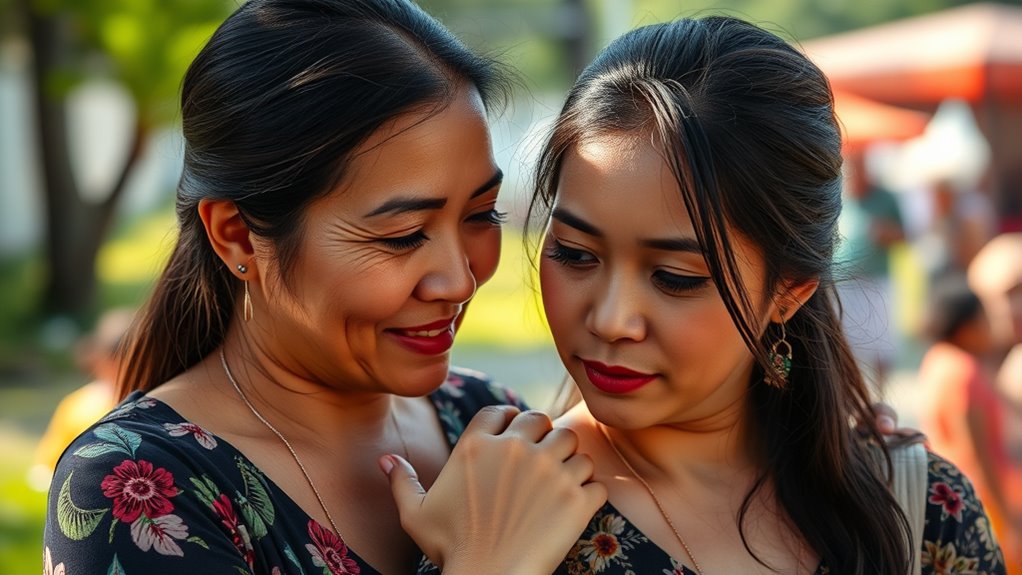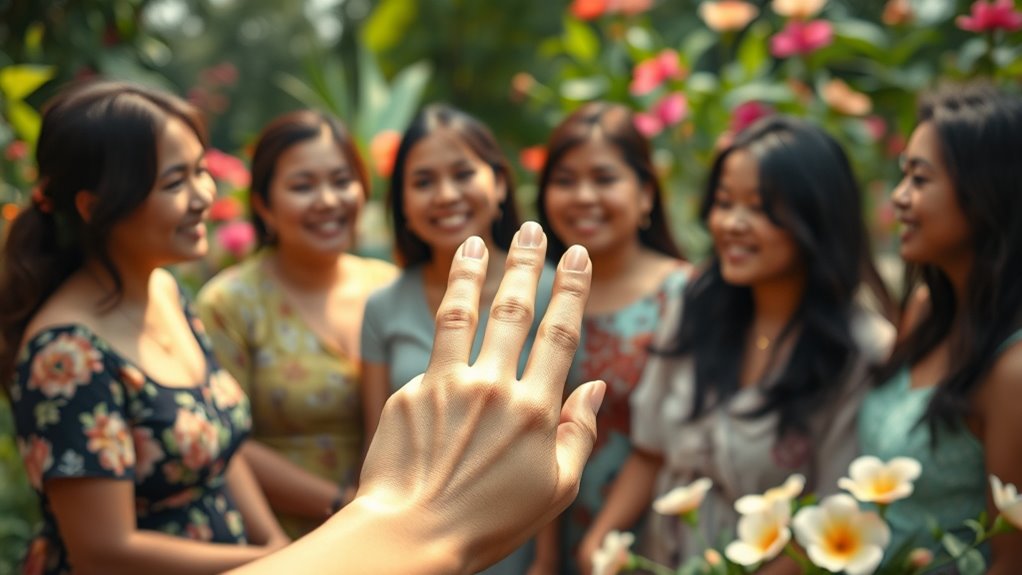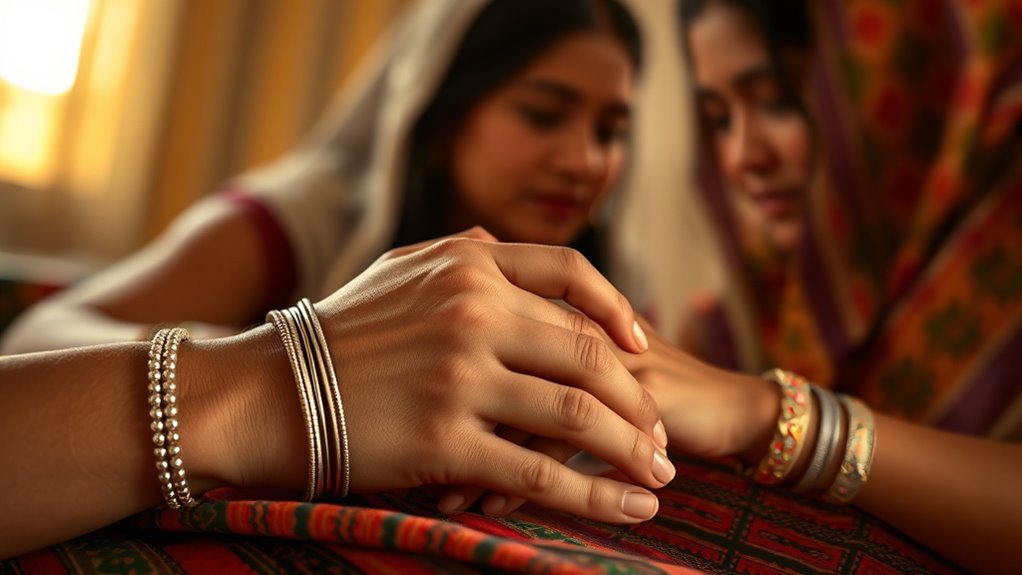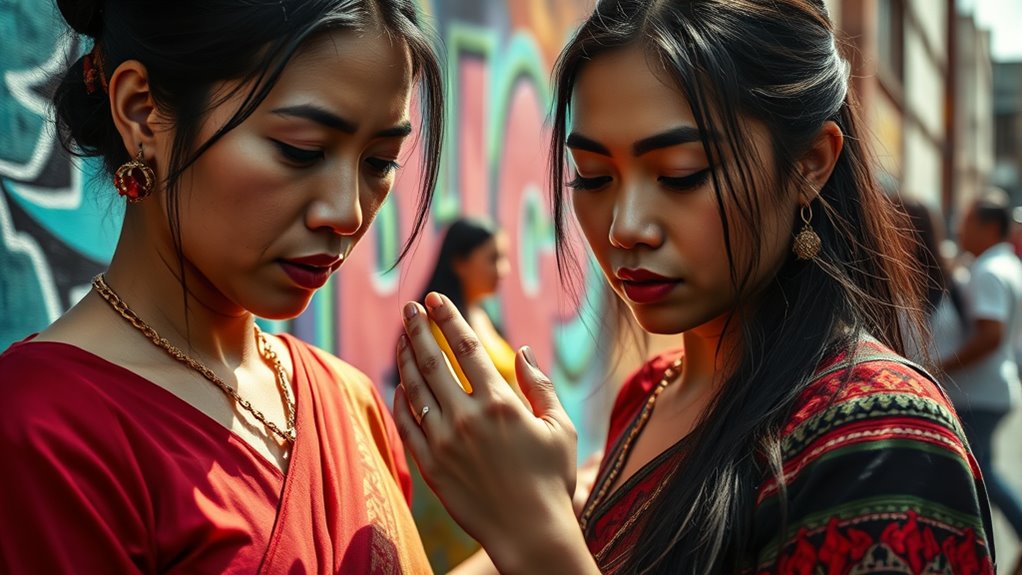Hiya, or shame, is essential in Filipina relationships because it cultivates respect, emotional intelligence, and social harmony. It helps you navigate interactions by regulating emotional expression and promoting indirect communication. This means you’re more aware of others’ feelings and maintain smooth connections, especially with elders. While you prioritize group harmony, it can also create challenges in open conversations. Discovering more about hiya can help you understand its deeper impact on relationships.
Key Takeaways
- Hiya fosters self-respect and social awareness, crucial for maintaining harmonious relationships in Filipina culture.
- It discourages confrontational behavior, promoting emotional stability and harmony among family and peers.
- Hiya encourages respectful communication, enhancing emotional intelligence and understanding in personal interactions.
- Navigating social hierarchies through hiya reinforces respect for authority and elders within Filipina communities.
- Generational differences in expressing hiya highlight the need for balanced communication to preserve cultural values while fostering openness.
The Essence of Hiya in Filipino Culture

In Filipino culture, the essence of hiya embodies a profound sense of self-respect and social awareness that shapes relationships and interactions. It goes beyond mere shame or embarrassment; it reflects your respect for yourself and others around you.
Hiya guides your behavior, pushing you to act considerately, especially in social settings. This awareness fosters emotional intelligence, helping you navigate interactions while maintaining harmony. Your conduct often reflects your upbringing and societal values, showcasing the importance of hiya.
In this context, respect and addressing others correctly, like using “kuya” or “ate,” highlight social hierarchies. Ultimately, hiya serves as a social regulator, ensuring smoother interactions and promoting group harmony over individual expression, which is essential in Filipino culture.
Hiya’s Role in Shaping Personal Relationships

While steering personal relationships, hiya plays an essential role in shaping how you express emotions and interact with others. It regulates your emotional expression, controlling the intensity of feelings you display, especially in public settings.
By discouraging confrontation, hiya helps maintain social harmony, though it might also prevent you from openly sharing your feelings, hindering deeper emotional connections. Culturally ingrained, hiya influences how you manage emotions within your family and community.
It prioritizes tact over openness, guiding you to communicate feelings indirectly to avoid offending others. By fostering respect for elders and promoting pakikisama, hiya encourages empathy and unity, ensuring that your relationships remain respectful and harmonious.
Emotional Intelligence and Hiya in Interactions

Understanding emotional intelligence in interactions requires recognizing the complex role hiya plays in Filipino culture. Hiya blends feelings of shame and guilt, shaping your self-awareness and tact in social situations. This cultural value promotes respectful communication, fostering harmony within your community.
While hiya serves as a virtue encouraging self-control, it can also evoke feelings of inadequacy, impacting how you express emotions. By being sensitive to others’ feelings, you create a supportive environment that respects self-esteem. However, the fear of causing shame might hinder open communication, complicating relationship dynamics.
Ultimately, hiya influences how you interact with authority and peers, ensuring that your behavior remains respectful and considerate, enhancing your overall emotional intelligence.
Navigating Social Hierarchies With Hiya

Hiya shapes not just personal interactions but also how you navigate social hierarchies in various settings.
In the Philippines, respect is key, especially toward authority figures. When you communicate, you’ll notice that your choice of words and tone adjusts depending on the status of those involved. With elders, you might use terms like *kuya* or *ate* to show deference.
This awareness helps maintain social harmony, as you prioritize relationship preservation over personal expression. Avoiding conflict is essential; you’ll often find yourself using non-threatening language to sidestep potential offense.
Understanding hiya allows you to build and maintain respectful connections, ensuring that your interactions remain smooth and considerate within the intricate social fabric of Filipino culture.
The Impact of Hiya on Family Dynamics

In Filipino families, the influence of hiya profoundly shapes communication and relationships. It encourages modesty and restraint, making you more likely to avoid open conflicts that could cause embarrassment. You might find yourself hesitating to express your thoughts around elders, who command respect, creating a hierarchy in conversations.
As a result, personal struggles often remain unaddressed, leading to unspoken tensions. Hiya serves as a social glue, promoting harmony by ensuring everyone adheres to cultural norms like using polite language.
While it fosters empathy and self-awareness, it can also lead to emotional suppression, particularly if you fear causing shame. Balancing tradition with modernity becomes challenging, as hiya influences family dynamics in profound ways.
Decision-Making Processes Influenced by Hiya

The influence of hiya extends beyond family dynamics and deeply permeates decision-making processes in Filipino culture. When making decisions, you’ll notice that maintaining group harmony often takes precedence over individual preferences. This emphasis on pakikisama encourages you to seek consensus, avoiding conflict and ensuring everyone feels respected.
Hierarchical structures play an important role, as decisions typically require approval from authority figures, reinforcing respect for their opinions. You might find that communication tends to be indirect, filtering information to prevent causing hiya.
In business settings, understanding these dynamics can greatly enhance your interactions, allowing you to navigate negotiations effectively while fostering strong relationships essential for success in Filipino culture.
Challenges Faced in Upholding Hiya Today

While maneuvering modern relationships, many Filipinos find it challenging to uphold hiya due to shifting cultural landscapes. You might feel the pressure of generational differences, as younger individuals often seek open communication while older generations cling to traditional values.
This clash complicates your ability to express feelings without fear of offending someone. Furthermore, the influence of technology and social media adds layers of complexity, making it harder to navigate hiya in your interactions.
You may find yourself self-censoring, suppressing your true emotions to maintain harmony. Balancing respect for cultural norms with the need for honest dialogue can be tough, but it’s essential for fostering healthier relationships in today’s evolving world.
The Future of Hiya in Modern Filipina Relationships

As societal norms continue to shift, the future of hiya in modern Filipina relationships will likely evolve, reflecting a blend of tradition and contemporary values.
You’ll find that younger generations are redefining hiya, viewing it as a tool for personal growth rather than a burden. In today’s digital age, social media amplifies expressions of hiya, influencing how you interact with others and navigate your relationships.
Globalization introduces diverse perspectives that challenge traditional notions, encouraging more open dialogues about shame. This evolution fosters a unique relational ethos, balancing personal desires with communal expectations.
Ultimately, the future of hiya will shape relationship dynamics, promoting respect and consideration while adapting to modern realities and fostering healthier connections.
Frequently Asked Questions
How Does Hiya Influence Romantic Relationships in Filipino Culture?
Hiya greatly influences romantic relationships in Filipino culture by guiding your behavior and responses.
You often self-regulate to avoid actions that could embarrass yourself or your partner. This creates a delicate balance, fostering respect and emotional connections.
While it encourages indirect communication, it can also complicate discussions about sensitive topics. You might prioritize public image over personal feelings, leading to a culture of non-confrontation where issues remain unaddressed, impacting intimacy.
Can Hiya Lead to Negative Mental Health Outcomes?
You might think hiya is just a cultural quirk, but it can seriously impact mental health.
Experiencing hiya often leads to anxiety and low self-esteem, as you may feel pressure to meet social expectations. This constant fear of dishonor can limit your emotional expression, making you feel isolated.
The stress from these societal pressures can even result in depression, highlighting the need to address hiya’s effects on mental well-being openly.
What Are Common Misconceptions About Hiya?
Common misconceptions about hiya include reducing it solely to shame, ignoring its role in social dynamics.
You might think hiya is just an emotion, but it also reflects community expectations. Translating hiya directly to “shame” misses its cultural depth.
It’s not a static concept; it evolves and can serve both as a virtue and vice.
Additionally, hiya influences not just individual actions but also family and community behaviors, impacting relationships markedly.
How Can One Effectively Communicate Hiya to Non-Filipinos?
Imagine a delicate thread weaving through a tapestry of relationships, where every interaction holds the weight of unspoken expectations.
To communicate hiya to non-Filipinos, you can start by painting vivid scenarios that illustrate its significance. Use relatable examples and invite open dialogue, ensuring they grasp its deeper meanings beyond mere shame.
Foster understanding by sharing stories and experiences, creating a bridge that connects cultural nuances and enriches the conversation about interpersonal dynamics.
Are There Specific Rituals or Practices Related to Hiya?
Yes, there are specific rituals and practices related to hiya in Filipino culture.
You’ll notice that greetings often involve showing respect to elders and using formal titles. Participating in community events like fiestas strengthens social bonds and helps avoid hiya.
Practicing pakikisama promotes harmony, while maintaining family honor is essential.
Conclusion
In a world where “hiya” could practically save the universe, it’s clear that this concept is a cornerstone of Filipina relationships. Embracing hiya means weaving respect, emotional intelligence, and family ties into the very fabric of your connections. As you navigate the complexities of modern life, remember that upholding hiya can open doors to deeper understanding and harmony. So, let’s not just cherish hiya; let’s make it the superhero of our relationships—capable of conquering even the toughest challenges!









